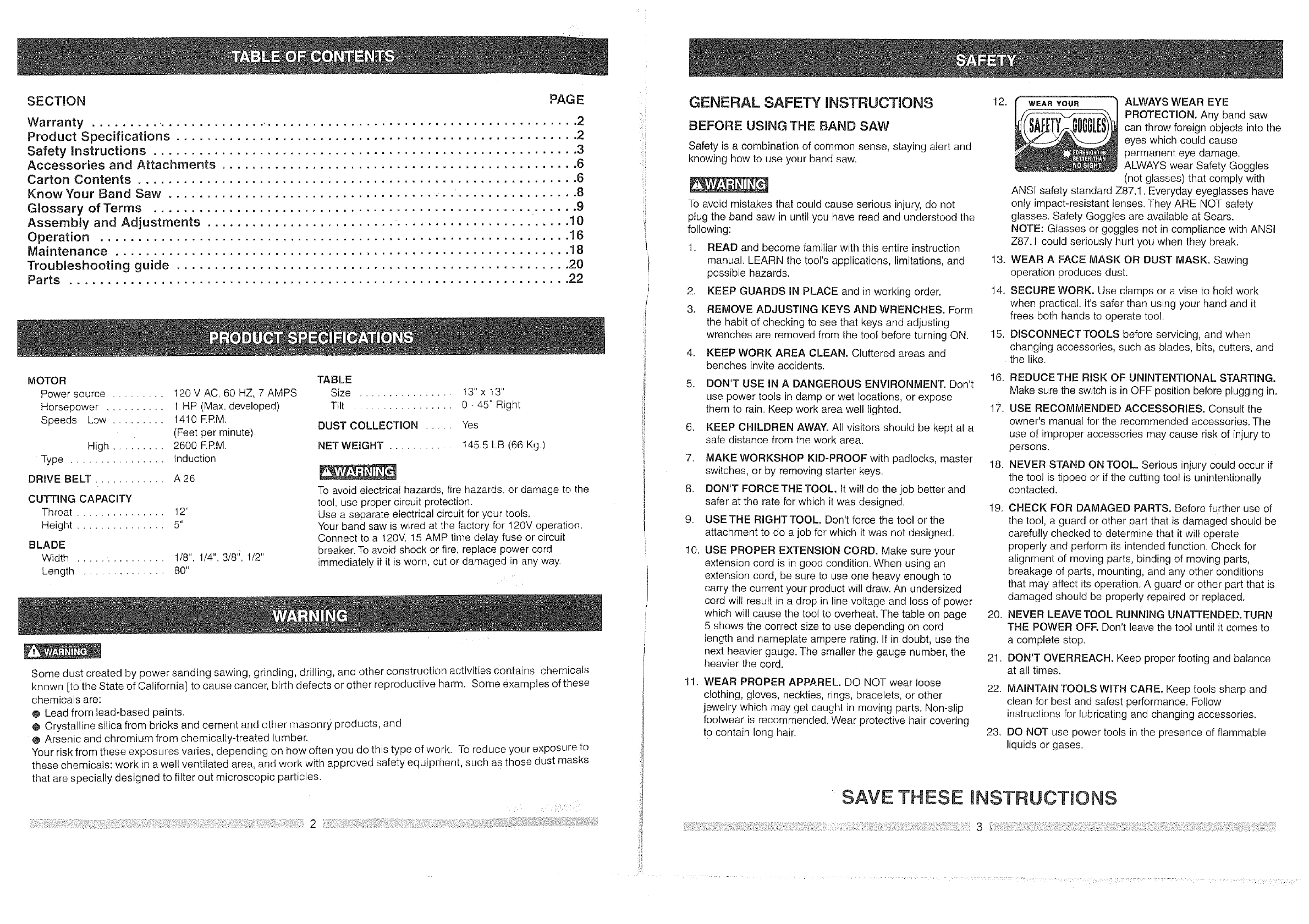
SECTION PAGE
Warranty ......... .............. ......................................... 2
Product Specifications ..................................................... 2
Safety Instructions ........................................................ 3
Accessories and Attachments ............................................... 6
Carton Contents ........................................................... 6
Know Your Band Saw ...................................... ................ 8
Glossary of Terms .................................................. ...... 9
Assembly and Adjustments ......................... ....................... 10
Operation .............................................................. 16
Maintenance ............................................................ 18
Troubleshooting guide .................................................... 20
Parts .................................................................. 22
MOTOR
Power source ......... 120 V AC, 60 HZ, 7 AMPS
Horsepower .......... 1 HP (Max. developed)
Speeds Low ......... 1410ERM.
(Feet per minute)
High ......... 2600 RRM.
Type ................ Induction
DRIVE BELT ............ A 26
CUTTING CAPACITY
Throat ............... 12"
Height ............... 5"
BLADE
Width ............... 1/8", 1/4". 3/8';. 1/2"
Length .............. 80"
TABLE
Size ................ 13" x 13"
Tilt ................. 0 - 45° Right
DUST COLLECTION ..... Yes
NET WEIGHT ........... !45.5 LB (66 Kg.)
To avoid electrical hazards, fire hazards, or damage to the
tool, use proper circuit protection.
Use a separate electrical circuit for your tools.
Your band saw is wired at the factory for 120V operation.
Connect to a 120',/,15 AMP time delay fuse or circuit
breaker. To avoid shock or fire, replace power cord
immediately if it is worn, cut or damaged in any way.
Some dust created by power sanding sawing, grinding, drilling, and other construction activities contains chemicals
known [to the State of California] to cause cancer, birth defects or other reproductive harm. Some examples of these
chemicals are:
® Lead from lead-based paints.
@ Crystalline silica from bricks and cement and other masonry products, and
@ Arsenic and chromium from chemically-treated lumber.
Your risk from these exposures varies, depending on how often you do this type of work. To reduce your exposure to
these chemicals: work in a well ventilated area, and work with approved safety equipment, such as those dust masks
that are specially designed to filter out microscopic particles.
;! i
GENERAL SAFETY INSTRUCTIONS
BEFORE USING THE BAND SAW
Safety is a combination of common sense, staying alert and
knowing how to use your band saw.
To avoid mistakes that could cause serious injury, do not
plug the band saw in until you have read and understood the
following:
1. READ and become familiar with this entire instruction
manual. LEARN the tool's applications, limitations, and
possible hazards.
2. KEEP GUARDS IN PLACE and in working order.
3. REMOVE ADJUSTING KEYS AND WRENCHES. Form
the habit of checking to see that keys and adjusting
wrenches are removed from the tool before turning ON.
4. KEEP WORK AREA CLEAN. Cluttered areas and
benches invite accidents.
5. DON'T USE IN A DANGEROUS ENVIRONMENT. Don't
use power tools in damp or wet locations, or expose
them to rain. Keep work area well lighted.
6. KEEP CHILDREN AWAY. All visitors should be kept at a
safe distance from the work area.
7.
8.
9.
10.
11.
MAKE WORKSHOP KID-PROOF with padlocks, master
switches, or by removing starter keys.
DON'T FORCE THE TOOL. It will do the job better and
safer at the rate for which it was designed.
USE THE RIGHTTOOL. Don't force the tool or the
attachment to do a job for which it was not designed.
USE PROPER EXTENSION CORD. Make sure your
extension cord is in good condition. When using an
extension cord, be sure to use one heavy enough to
carry the current your product will draw. An undersized
cord will result in a drop in line voltage and loss of power
which wilt cause the tool to overheat. The table on page
5 shows the correct size to use depending on cord
length and nameplate ampere rating. If in doubt, use the
next heavier gauge. The smaller the gauge numbeq the
heavier the cord.
12.
13.
14.
15.
WEARYOUR ALWAYS WEAR EYE
PROTECTION. Any band saw
can throw foreign objects into the
eyes which could cause
permanent eye damage.
ALWAYS wear Safety Goggles
(not glasses) that comply with
ANSI safety standard Z87.1, Everyday eyeglasses have
only impact-resistant lenses. They ARE NOT safety
glasses. Safety Goggles are available at Sears.
NOTE: Glasses or goggles not in compliance with ANSI
Z87,1 could seriously hurt you when they break.
WEAR A FACE MASK OR DUST MASK. Sawing
operation produces dust.
SECURE WORK. Use clamps or a vise to hotd work
when practical. It's safer than using your hand and it
frees both hands to operate tool.
DISCONNECTTOOLS before servicing, and when
changing accessories, such as blades, bits, cutters, and
• the like.
16. REDUCETHE RISK OF UNINTENTIONAL STARTING.
Make sure the switch is in OFF position before plugging in.
17. USE RECOMMENDED ACCESSORIES. Consult the
owner's manual for the recommended accessories. The
use of improper accessories may cause risk of injury to
persons,
18. NEVER STAND ON TOOL. Serious injury could occur if
the tool is tipped or if the cutting tool is unintentionally
contacted.
19. CHECK FOR DAMAGED PARTS. Before further use of
the tool, a guard or other part that is damaged should be
carefully checked to determine that it will operate
properly and perform its intended function. Check for
alignment of moving parts, binding of moving parts,
breakage of parts, mounting, and any other conditions
that may affect its operation. A guard or other part that is
damaged should be properly repaired or replaced.
20. NEVER LEAVE TOOL RUNNING UNATTENDED.TURN
THE POWER OFF. Don't leave the tool until it comes to
a complete stop,
21. DON'T OVERREACH. Keep proper footing and balance
at all times.
WEAR PROPER APPAREL. DO NOT wear loose
22.
clothing, gloves, neckties, rings, bracelets, or other
jewelry which may get caught in moving parts. Non-slip
footwear is recommended. Wear protective hair covering
to contain long hair. 23.
MAINTAIN TOOLS WITH CARE. Keep tools sharp and
clean for best and safest performance. Follow
instructions for lubricating and changing accessories.
DO NOT use power tools in the presence of flammable
liquids or gases.
SAVE THESE NSTRUCT ONS
3
















